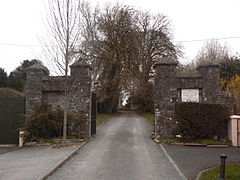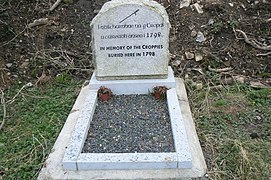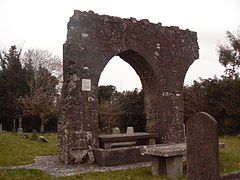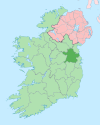Dunshaughlin
Dunshaughlin Dún Seachlainn/Domhnach Seachnaill | |
|---|---|
Town | |
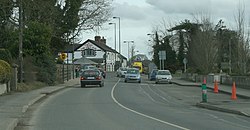 The Drumree Road in Dunshaughlin | |
| Coordinates: 53°30′42″N 6°32′22″W / 53.5118°N 6.5395°W | |
| Country | Ireland |
| Province | Leinster |
| County | County Meath |
| Elevation | 105 m (344 ft) |
| Population | 6,644 |
| Time zone | UTC+0 (WET) |
| • Summer (DST) | UTC-1 (IST (WEST)) |
| Irish Grid Reference | N965526 |
Dunshaughlin (Irish: Dún Seachlainn, meaning 'the fort of Seachlainn'[2] or locally Irish: Domhnach Seachnaill, meaning 'St Seachnall's Church')[3] is a town in County Meath, Ireland. A commuter town for nearby Dublin,[4] Dunshaughlin more than tripled in population (from 2,139 to 6,644 inhabitants) between the 1996 and 2022 censuses.[5] The town is in a townland and civil parish of the same name.[2]
History
Foundation
Dunshaughlin is named for Saint Seachnall, who established a church there in the 5th century, where he is said to be buried.[6] The oldest reference to the place name is an entry in the Annála Uladh from the year 801, where the name takes the form "Domnaig Sechnaill". The word "Domnach", used in this way, can be attributed to churches which originate from the beginnings of Christianity in Ireland.[7] North of the ruins of the original church on the site there is a Church of Ireland church built in 1814 with funds from the Board of First Fruits.


Máel Sechnaill mac Domnaill was an ancestor from which the principal family of Brega, Ó Maoilsheachlainn, is descended. Dunshaughlin (or more specifically, the townland of Lagore) is famous for an ancient crannóg or settlement from the 7th century where a number of Irish antiquities were discovered.[citation needed]
Workhouse
Approximately 2 km (1.2 mi) from the village is a preserved workhouse from the Great Famine. This workhouse was erected in 1840–41 on 2 hectares (4.9 acres), south of Dunshaughlin. Designed to accommodate 400 inmates, it cost about £6,000 to build, all told. It was declared fit for habitation on 12 May 1841 and received its first admissions on 17 May. During the famine period, in the mid-1840s, elements of the workhouse were converted to accommodate additional inmates, and a burial ground was located to the rear. Occupancy declined after the famine. During the First World War, the building was used to house Belgian refugees, some of whom died there and were buried in the paupers' graveyard. In 1920–21, the building was taken over by the Black and Tans, who used it as a barracks during the Irish War of Independence. After the workhouse system was abolished in 1922, following the conclusion of the war and the establishment of Irish Free State, the facility served as a school, courthouse, and factory (among other things). As of 2002, parts of the building were being used as a guest residence.[8]
Demographics
Dunshaughlin is 29 km from Dublin on the R147, and is a growing satellite town of that city.[9] In the 20 years between the 1991 and 2011 census, the town's population had more than tripled from 1,275 inhabitants to 3,903 people.[5][10] By the time of the 2022 census, this had further increased to 6,644.[5]
Amenities
Several housing estates centre on the main street, with multiple retail units consisting of newsagents, pubs, takeaway food outlets, clothing stores, and banks. There is also a business park on the outskirts of the town.[11]
Dunshaughlin houses a number of public amenities, including a library, a health centre, and the Meath County Council civic offices. A community and sports centre was opened on the grounds of Dunshaughlin Community College in 2000. The centre is operated by a voluntary board of management.[12]
Education
Dunshaughlin has three primary schools, Gaelscoil na Ríthe, St. Seachnall's and Dunshaughlin Community National School. It has two secondary schools, Dunshaughlin Community College and Coláiste Ríoga. St. Seachnall's was founded in 1835. As of 2019, it had 552 students, both boys and girls.[13] Gaelscoil na Ríthe (an Irish medium school) was established in 1985 by a group of parents from the Dunshaughlin, Drumree, and Culmullen areas. A new building was constructed in 1996 and, as of 2019, the school had an enrollment of 226 pupils.[14] Dunshaughlin Community College (DCC), established in 1933, is a co-educational school which is part of the Louth and Meath Education and Training Board. Construction was completed on an extension at the school in 2013, and was officially opened on 29 November 2014.[15]
Transport
Dunshaughlin is located at a junction between the R147 and R125 regional roads, and approximately 1 km from the M3 motorway. It is served by Bus Éireann commuter bus services to Dublin, including route 109, which generally runs at a frequency of every half-hour.[16]
Sport

The town is represented in sport by men's and ladies Gaelic football teams. The Dunshaughlin GAA men's team were Meath Senior Football Championship for three consecutive seasons (2000 to 2003). The local soccer club is Dunshaughlin Youths,[17] which fields teams in the North Dublin Schoolboys League.[18]
The local basketball club, Dunshaughlin Rockets, compete in both the North East Basketball League and the Dublin Ladies Basketball League. Dunshaughlin community college has won both a girl's u16 All-Ireland title, a second-year girl's All-Ireland a boy's u19 All-Ireland title.[19]
Dunshaughlin Athletic Club is traditionally considered a long-distance running club. However, club members have also entered juvenile sprinting competitions.[citation needed] The town's golf course is the "Black Bush Golf Club". Around 3 km (1.9 mi) outside the village a new golfing resort designed by Jack Nicklaus has been created at Killeen Castle. The course hosted the 2011 Solheim Cup.[20]
The town also has a strong association with horse racing,[citation needed] in particular National Hunt racing. The leading flat race sprinter Sole Power, dual winner of both the Nunthorpe Stakes and the King's Stand Stakes, is trained near the town by Edward Lynam.[21]
Events
The Dunshaughlin Harvest Festival is a three-day culture festival, usually taking place towards the end of September. It is a non-profit event, organized and run by local volunteers.[22]
Gallery
- Entrance to Saint Seachnall's Church of Ireland, site of the village's original ecclesiastical foundation in the fifth century AD
- Waterfall next to the old mill on the Killeen Road
- 1798 Croppy Commemoration, Croppy Lane, Trim Road
- Remains of the monastic site of Saint Seachnall, Domhnach Seachnaill, from which the town's name derives
- A hot-air balloon over north-west Dunshaughlin
See also
References
- ^ "F1015: Population and Average Age by Sex and List of Towns (number and percentages), 2022". Census 2022. Central Statistics Office. April 2022. Retrieved 29 June 2023.
- ^ a b "Dunshaughlin / Dún Seachlainn". logainm.ie. Placenames Database of Ireland. Archived from the original on 2 April 2015. Retrieved 16 March 2015.
- ^ While Domhnach Seachnaill remains the common name among the natives, since the Placenames Order, 1975 the alternative recorded Irish name for the town, Dún Seachlainn, is designated as the official name. Both names are equally legitimate with Domhnach Seachnaill appearing in ecclesiastical records and Dún Seachlainn appearing in secular records.
- ^ "More than 900 housing units approved for Dunshaughlin, Co Meath". dublinlive.ie. 26 April 2019. Archived from the original on 22 September 2020. Retrieved 16 February 2020.
- ^ a b c "Dunshaughlin (Ireland) Census Town". City Population. Retrieved 30 June 2023.
- ^ Archdall, Mervyn (1786). Monasticon Hibernicum or A history of the Abbies Priories and Other Religious Houses in Ireland. Luke White Press.
- ^ "Dún Seachlainn/Dunshaughlin". Logainm.ie. 25 May 2017. Archived from the original on 21 August 2017. Retrieved 20 August 2017.
- ^ "The Workhouse in Dunshaughlin, Co. Meath". workhouses.org.uk. Archived from the original on 5 February 2020. Retrieved 16 February 2020.
- ^ "Dunshaughlin Local Area Plan 2009-2015" (PDF). meath.ie. Meath County Council. Archived (PDF) from the original on 24 May 2019. Retrieved 16 February 2020.
Many people residing in Dunshaughlin work elsewhere, mostly in Dublin
- ^ "Area Profile For Town - Dunshaughlin Co. Meath" (PDF). census.cso.ie. Central Statistics Office. 2011. Archived (PDF) from the original on 15 January 2018. Retrieved 16 February 2020.
- ^ "Changing face of Dunshaughlin as development takes off again". meathchronicle.ie. Meath Chronicle. 13 January 2019. Archived from the original on 16 February 2020. Retrieved 16 February 2020.
- ^ "About us - Dunshaughlin Community Centre Ltd". Dunshaughlincommunitycentre.ie. Archived from the original on 21 August 2017. Retrieved 20 August 2017.
- ^ "Find a school - St Seachnall's National School". Department of Education. Retrieved 4 August 2020.
- ^ "Find a school - Gaelscoil Na Rithe". education.ie. Department of Education. Retrieved 4 August 2020.
- ^ "Principal Message". dunshaughlincc.ie. Archived from the original on 14 October 2016. Retrieved 5 December 2016.
- ^ "Timetable / Route 109 / Kells - Navan - Dunshaughlin - Dublin" (PDF). buseireann.ie. Bus Éireann. Archived (PDF) from the original on 23 December 2019. Retrieved 16 February 2020.
- ^ "DUNSHAUGHLIN YOUTHS FC". DUNSHAUGHLIN YOUTHS FC. Archived from the original on 21 August 2017. Retrieved 21 August 2017.
- ^ "Welcome to North Dublin Schoolboys/Girls League". Ndsl.ie. Archived from the original on 11 August 2021. Retrieved 21 August 2017.
- ^ "Basketball Club". Dunshaughlin Rockets. Archived from the original on 21 August 2017. Retrieved 20 August 2017.
- ^ Kelly, Tom (5 October 2011). "Dunshaughlin students praised for Solheim Cup catering role". Meath Chronicle. Archived from the original on 11 May 2012. Retrieved 17 April 2020.
- ^ "Edward Lynam". Racing Post. Archived from the original on 7 April 2019. Retrieved 20 August 2017.
- ^ "About - Dunshaughlin Harvest Festival". dunfest.com. Archived from the original on 15 August 2018. Retrieved 16 February 2020.


